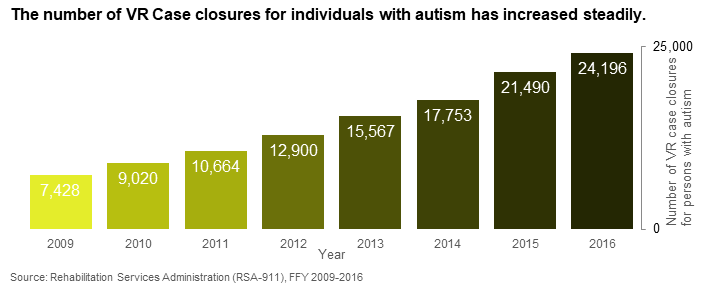Employment Policy and Autism
By Anne Roux, MPH
Posted on
October 10, 2019
State Vocational Rehabilitation (VR) programs are a key source of public employment services for people with disabilities, and the number of people with autism who use VR services grows every year. The federal government authorizes approximately $3.5 billion annually to fund state VR programs.

State VR agencies lack capacity to meet the growing demands of autism population.
Overall, states lack capacity to meet the employment-related needs of this growing population. Employment outcomes for people on the spectrum remain overwhelmingly poor.
People with autism have a complex array of challenges related to employment mixed with strengths in memory, focus, in depth knowledge, and more. The needs of people with autism don’t always fit the mold of how VR services are provided. VR often closes a case after a person has had a job for 90 days. But people with autism may need ongoing, flexible supports to deal with changes in the workplace or new job tasks.
Every state has a written plan for implementing VR services.
Each state has a federally approved plan for how it will implement regulations that govern VR programs. These plans are referred to as “WIOA state plans,” because they are responsive to the Workforce Innovation and Opportunity Act (WIOA) of 2014. The most recent state plans were completed in 2016. We wanted to know whether and how the 2016 state WIOA plans addressed the needs of people on the autism spectrum.

What do state WIOA plans say about autism?
Despite the overwhelming evidence that the size of the autism population is growing, states are just beginning to recognize and talk about the employment needs of people with autism.
We found that:
- Seven state plans had no mention of autism (Arizona, Hawaii, Idaho, New Mexico, Ohio, West Virginia, Wyoming).
- Who are the trendsetters? Twelve states named autism-specific services or programs they were using to meet the needs of people with autism and other developmental disabilities (Alabama, California, Delaware, Kentucky, Maryland, Michigan, Missouri, New Hampshire, Oklahoma, South Carolina, Texas, Virginia). These states are leading the way in appropriate responses to the increased need for autism-informed services.
“Concern was expressed at all levels about the job readiness preparation this group will have as they exit school, the preparedness of the adult vocational rehabilitation agency staff to provide services, and the availability of supported employment services for this population.” (Michigan 2016 State WIOA Plan)
- Examples of innovations states were using to serve people with autism included use of autism specialists, novel funding models, and development of standards of practice such as requiring specific training for providers who will serve people with autism.
- Nineteen states named autism as a group that is underserved by VR in that state. States had the opportunity to specify goals and strategies for how to better meet the needs of underserved groups.
- Twenty-five states named strategies, goals or objectives that referenced autism specifically. However, only 10 states had plans that were “comprehensive.” We defined comprehensive plans as those that named autism as an underserved group, specified strategies for better meeting the needs of the autism group, and tied these strategies to a specific goal. These states were Alabama, Connecticut, Georgia, Kentucky, Maryland, Missouri, New York, Texas, Virginia, Washington.
- Many states mentioned the need for more autism training for VR service providers to increase their competency to serve this population. But there were few standards in place for who would provide training and how.
- Some states said they needed more service options for people with autism (Connecticut, Georgia, Illinois, Maryland, New Hampshire, New York, Texas) or long-term supported employment services for people with autism (California, Minnesota, Missouri, North Carolina, Nebraska, Wisconsin), as VR services are generally designed to be a short-term intervention.
Did you know? WIOA directs each state to set aside 15% of its VR budget to fund Pre-Employment Transition Services (Pre-ETS) to provide assistance to students who had a disability or were suspected of having a disability that might affect employment.
- States commonly mentioned the needs of youth with autism. While 30 states mentioned the employment needs of transition-age youth with autism, only Kentucky mentioned how they might use a portion of their Pre-Employment Transition Service (Pre-ETS) funds to serve students with autism.
- People with autism come from many racial, ethnic, and cultural backgrounds, but states did not mention strategies for outreach to diverse groups within the autism community.